|
TennisOne Lessons Essential Tennis Skills by Participating in sports such as basketball, football, baseball, soccer, track and field etc. develop athletic skills from early childhood. Some of these skills are complementary to tennis and are naturally integrated into the development of a player’s game. However, there are certain specific tennis skills that must override the instinctive reaction of a player. These skills can be learned by observation and imitation, or they can be learned in a step-by-step manner. The Serve
Acquired Skill: To join that elite 20% group of tennis players, it is essential to hold the racquet with a continental grip -- This grip is similar to holding a hammer. With the continental grip the racquet approaches the ball on edge then the arm pronates inward to meet the ball square on for a flat serve. Skilled players can also manipulate the exact angle of impact to impart various spins to the ball. Racquet Preparation
Acquired Skill: The first move should be an instantaneous "unit turn" with the shoulders, hips, upper body and the racquet turning sideways together. From this ready position, the racquet is taken back in a continuous loop throughout the forward swing into the ball. By lowering the racquet below the height of the ball, a topspin stroke can be played -- or if the racquet comes from above the height of the ball, underspin can be imparted. But the initial move remains the same. The Overhead Smash
Acquired Skill: To handle lobs, the first move a player makes is to turn sideways, then side step backwards if the lob is not too deep. When a deep lob comes, the player must acquire the habit of stepping forward with the left foot and then use cross over steps and finish the smash with a jump and a scissors kick.
The Volley
Acquired Skill: All good volleyers have acquired the skill to be on the balls of their feet and make a split step just as the opponent is about to hit the ball, and then to start moving as soon as the opponent hits the ball. The volleyer immediately sets the hand and either blocks the ball or pushes through the ball with a firm wrist.
High Backhands
Acquired Skill: The player has to acquire the skill to be father away from a high bouncing ball in order to hit a backhand with a firm wrist. Judging the Rebound of the Ball.
Acquired Skill: An experienced player has acquired the skill to visualize the flight of the ball from the moment the opponent has made the stroke. The player judges where the first bounce is likely to be and, as soon as the ball bounces, visualizes where the second bounce will be and immediately tries to adjust to meet the ball at the optimum point of contact. Playing A Deep Ball
Acquired Skill: To play a higher level, it is important not to give up too much territory behind the baseline because this puts the player in a defensive position. The player must acquire the skill of moving forward on the high, deep ball and play it while it is on the rise. From these few examples, it should be clear that Tennis Specific Skill Acquisition is essential to reach a higher level of play. Your comments are welcome. Let us know what you think about Dennis Van der Meer's article by emailing us here at TennisOne.
Dennis Van der Meer and his staff can be reached in the USA by phoning 1-800-845-6138 or faxing (843) 785-7032. From outside the United States, dial 001-843-785-8388 and fax 001-843-785-7032. Send E-Mail to tennis@vandermeertennis.com or stop by the web site: www.vandermeertennis.com |


 Instinctive Skill: Approximately 80% of people playing tennis have mediocre serves because the instinct is to grip the racquet in such a way that the racquet face is square to the net as it is approaching the ball.
Instinctive Skill: Approximately 80% of people playing tennis have mediocre serves because the instinct is to grip the racquet in such a way that the racquet face is square to the net as it is approaching the ball. 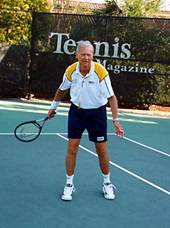
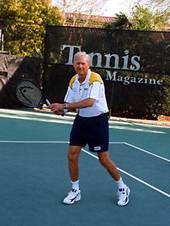 Instinctive Skill: The instinct is to face the net and draw the racquet down towards the ground in a scooping motion (left).
Instinctive Skill: The instinct is to face the net and draw the racquet down towards the ground in a scooping motion (left).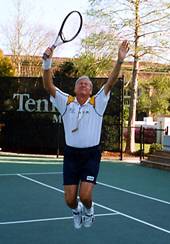
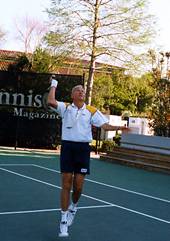 Instinctive Skill: As a kind of a joke shot, Pete Sampras has led a score of players in facing the net on a short lob and then jumping straight up in the sky.
Instinctive Skill: As a kind of a joke shot, Pete Sampras has led a score of players in facing the net on a short lob and then jumping straight up in the sky. 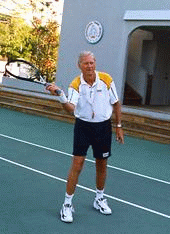
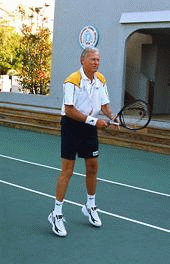 Instinctive Skill: The instinct is to start moving from a stationary position, and then to swat at the ball with a loose wrist (left).
Instinctive Skill: The instinct is to start moving from a stationary position, and then to swat at the ball with a loose wrist (left).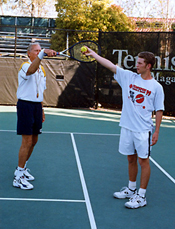
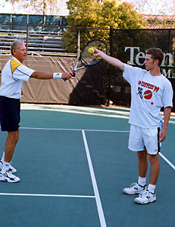 Instinctive Skill: Once the player has instinctively discovered how far to be from the ball on a waist-high backhand, a solid stroke can be played. However, when the ball rebounds high, the player is too close to the ball and has to break the wrist (left), which results in a weak stroke.
Instinctive Skill: Once the player has instinctively discovered how far to be from the ball on a waist-high backhand, a solid stroke can be played. However, when the ball rebounds high, the player is too close to the ball and has to break the wrist (left), which results in a weak stroke.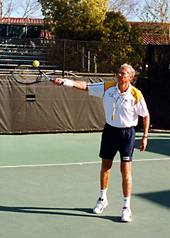
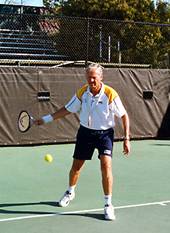 Instinctive skill: The instinct of a player is to rush to the spot where the ball has bounced. The result is a hurried stroke (left).
Instinctive skill: The instinct of a player is to rush to the spot where the ball has bounced. The result is a hurried stroke (left).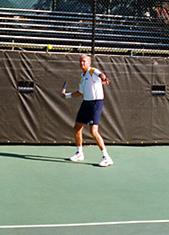
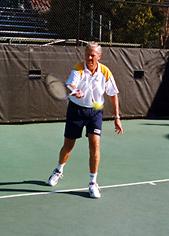 Instinctive Skill: The instinct is to run backwards, perhaps all the way to the back fence, to retrieve a deep ball.
Instinctive Skill: The instinct is to run backwards, perhaps all the way to the back fence, to retrieve a deep ball. 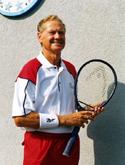 Dennis Van der Meer, voted U.S. Olympic Development Coach of the Year, has taught more people to play and teach tennis than anyone in the history of the game.
Dennis Van der Meer, voted U.S. Olympic Development Coach of the Year, has taught more people to play and teach tennis than anyone in the history of the game.